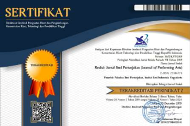The Use of Growl Vocal Technique to Enhance Voice Quality in Singing Pop Songs
Abstract
This study aims to provide solutions for students of Music Education Study Program of Indonesia Institute of the Arts Yogyakarta who face problems in singing pop songs, particularly to reach high notes. Growl is a kind of vocal technique for producing growling sounds. Initially, Growl vocal technique was used by metal or rock vocalists. However, this technique can be applied to pop songs as a variation. As a result, it can be functioned as a solution to reach high notes for the singers having low range of notes. This study focused on the process of practicing Growl vocal technique and the use of Growl when singing pop songs. The author implemented qualitative method emphasizing on cas study approach. The data collection was carried out through literature studies, observations, and interviews by selecting sample from the respondents engaging in this study case in which the subjects of the study were Pop Jazz vocal students in Music Education Study Program of Indonesia Institute of the Arts Yogyakarta. The application of Growl Vocal Technique is highly efficacious when singing both low and high notes in legato manner. In addition, Growl can be an emphasis on the specific lines of song lyrics to convey the enotional meaning of that part. Furthermore, it also can be functioned as an alteration to create divergence of a singer in using vocal techniques when singing. It leads to a novelty that the use of Growl vocal technique can be said to be an aesthetic expression to make voice much more amusing.
Keywords
Full Text:
PDFReferences
Andaryani, E. T. (2011). Persepsi Masyarakat Terhadap Pertunjukan Musik Dangdut Organ Tunggal. Harmonia: Journal of Arts Research and Education, 11(2), 163–172. https://doi.org/10.15294/harmonia.v11i2.2209
Bintarto, A. G. (2014). Aspek Olah Vokal Musik Klasik Barat pada Musik Populer. Journal of Urban Society’s Arts, 1(1), 44–56. https://doi.org/10.24821/jousa.v1i1.787
Christy, D. E., Suryadi, A., & Artikel, I. (2019). Musik Keroncong Di Surakarta: Perjalanan Dari Tahun 1960 Hingga 1995. Indonesian Journal of Conservation, 8(1), 1–10. https://www.mendeley.com/catalogue/a7a1a5f1-c1aa-3e4c-922a-266a437f8f1c/
Elmoulat, M., Brahim, L. A., Elmahsani, A., Abdelouafi, A., & Mastere, M. (2021). Mass Movements Susceptibility Mapping by Using Heuristic Approach. Case study: province of Tétouan (North of Morocco). Geoenvironmental Disasters, 8(1). https://doi. org/10.1186/s40677-021-00192-0
Irawati, E. (2021). Transmisi, Kesinambungan, & Ekosistem Kunci Musik Tradisi. Yogyakarta: Art Music Today.
Irawati, Eli. (2021). The Transmission of Resilience Learning in the Context of Formal Education an Ethnomusicological Review. Linguistics and Culture Review, 5 (S3), 1040-1053. https://doi.org/10.21744/lingcure.v5nS3.1664
Krause, M., Müller, M., & Weiß, C. (2021). Singing Voice Detection in Opera Recordings: A Case Study on Robustness and Generalization. Electronics (Switzerland), 10(10). https://doi.org/10.3390/electronics10101214
Laksono, K. L. (2015). Musik Hip-Hop sebagai Bentuk Hybrid Culture dalam Tinjauan Estetika. Resital: Jurnal Seni Pertunjukan, 16(2), 75–83. https://doi.org/10.24821/resital.v16i2.1507
Paputungan, F. T., & Lapian, A. (2020). Penerapan Metode Imitasi dan Drill pada Paduan Suara Manado Independent School. Clef: Jurnal Musik dan Pendidikan Musik, 1 (1),11–21. https://ejournal-iakn-manado.ac.id/index.php/clef/article/view/129
Perlovsky, L. (2010). Musical emotions: Functions, origins, evolution. Physics of Life Reviews, 7(1), 2–27. https://www.sciencedirect.com/science/article/abs/pii/S157
Pambajeng, N. R. S., Suryati, S., & Musmal, M. (2019). Teknik Vokal dan Pembawaan Lagu Keroncong Stambul “Tinggal Kengangan” Ciptaan Budiman BJ oleh Subarjo HS. Promusika, 7(1), 29–37. https://doi.org/10.24821/promusika.v7i1.3166
Pandaleke, S. M., & Jazuli, M. (2016). Catharsis Makna Nyanyian Ma’zani Bagi Masyarakat Petani di Desa Rurukan Kota Tomohon. Catharsis: Journal of Arts Education, 5(1), 41–47. https://journal.unnes.ac.id/sju/index.php/catharsis
Pratama, Z. W., Setyoko, A., & Purwanti, P. (2023). Bedandeng Kutai: Ornamentasi Melismatis Dalam Bedandeng Kutai. Keteg: Jurnal Pengetahuan, Pemikiran Dan Kajian Tentang Bunyi, 22(2), 109–117. https://doi.org/10.33153/keteg.v22i2.4538
Pramudya, N. A. (2019). Penciptaan Karya Komposisi Musik sebagai Sebuah Penyampaian Makna Pengalaman Empiris Menjadi Sebuah Mahakarya. Gelar: Jurnal Seni Budaya, 17(1), 14–23. https://doi.org/10.33153/glr.v17i1.2597
Rachman, A., & Lestari, W. (2012). Bentuk Aransemen Musik Keroncong Asli Karya Kelly Puspito dan Relevansinya Bagi Remaja dalam Mengembangkan Musik Keroncong Asli. Catharsis: Journal of Arts Education, 1(2), 11–15. http://journal.unnes.ac.id/sju/index.php/catharsis
Rachman, A., Pangesty, S. D., Haryono, S., Lestari, W., Seni, P., & Semarang, U. N. (2022). Improvisasi Melodi Instrumen Flute dalam Musik Keroncong. Jurnal Pendidikan dan Kajian Seni (JPKS), 7(2), 146–158. http://dx.doi.org/10.30870/jpks.v7i2.16685
Rahmat, S. P. N., Saad, S. B., & Irawati, E. (2022). Typological Analysis of Metalhead Community’s Logo as Visual Communication During Covid-19 Pandemic. Journal of Urban Society's Arts, 9(1), 33-47. https://doi.org/10.24821/jousa.v9i1.7073
Setiasih, N. W. (2019). Konsep Slamming pada Anatomi Huruf Dan Tipografi Band Rezume. Journal of Urban Society’s Arts, 5(2), 94–101. https://doi.org/10.24821/jousa.v5i2.2156
Sinaga, T. (2014). Teknik bernyanyi dalam paduan suara. Generasi Kampus, 7(2). 281-293. https://jurnal.unimed.ac.id/2012/index.php/gk/article/view/7395
Sinaga, T. (2018). Dasar-Dasar Teknik Bernyanyi Opera. Gondang: Jurnal Seni Dan Budaya, 2(2), 79–89. https://www.neliti.com/id/publications/408827/dasar-dasar-teknik-bernyanyi-opera
Siringoringo, J. E., Siringoringo, V. M., & Silaban, B. B. H. (2021). Pendampingan Dan Pelatihan Tim Musik Song Leader Gereja Di Kecamatan Medan Amplas: Indonesia. Jurnal PKM Setiadharma, 2(3), 151–159. https://jurnal.sttsetia.ac.id/index.php/pkm/article/view/205
Sugiyono. (2011). Metode Penelitian Kuantitatif, Kualitatif dan R&D. Bandung: Alfabeta
Silitonga, P. H. D. (2017). Ansambel Musik Batak Toba Sebagai Pengiring dalam Peribadata Umat Kristen Etnis Batak Toba di Medan. Gondang: Jurnal Seni dan Budaya, 1(2), 70–77. https://jurnal.unimed.ac.id/2012/index.php/GDG/article/view/8565
Suryati, S. (2021). Pemanfaatan YouTube sebagai Media Pembelajaran Vokal Pop Jazz di Prodi Pendidikan Musik Institut Seni Indonesia Yogyakarta. Resital: Jurnal Seni Pertunjukan, 22(2), 117–126. https://doi.org/10.24821/resital.v22i2.6040
Utomo, W. dan U. (2018). Pengembangan Materi Ajar Seni Budaya Sub Materi Musik pada Sekolah Umum Jenjang Pendidikan Dasar. Resital: Jurnal Seni Pertunjukan, 17(2), 87– 97. https://journal.isi.ac.id/index.php/resital/article/view/2221
DOI: https://doi.org/10.24821/resital.v24i2.7934
Refbacks
- There are currently no refbacks.
This work is licensed under a Creative Commons Attribution 4.0 International License.




